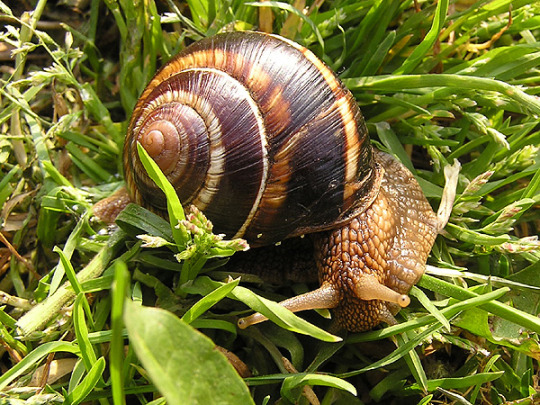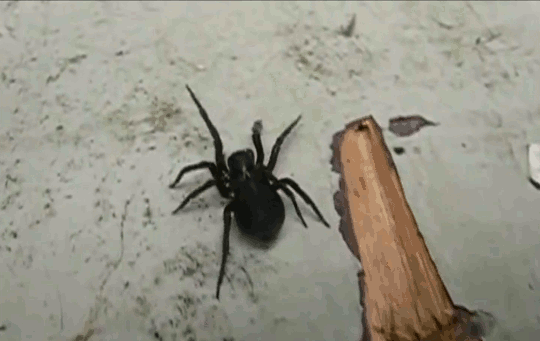#hemolymph fractions
Explore tagged Tumblr posts
Text
Antioxidant activity of fractions isolated from hemolymph of garden snail Helix lucorum
Antioxidant activity of fractions isolated from hemolymph of garden snail Helix lucorum
Image: Wikimedia Article published in the Journal of Pharmacy & Pharmacognosy Research 9(2): 143-152, 2021. Original Article Albena Alexandrova1,3*, Lubomir Petrov1,3, Lyudmila Velkova2, Aleksander Dolashki2, Elina Tsvetanova3, Almira Georgieva3, Pavlina Dolashka2 1Department of Physiology and Biochemistry, National Sports Academy, 21, Acad. Stefan Mladenov, str., 1700 Sofia,…

View On WordPress
0 notes
Photo

There’s something about the way spiders move that many of us find inherently creepy. And that something, it turns out, is fluid dynamical. Unlike humans and other vertebrates, spiders don’t move using two sets of opposing muscles. The natural state of their multi-jointed legs causes them to flex inward. This is why dead spiders have their legs all curled up.
To walk, spiders use hydraulic pressure. They pump a fluid called hemolymph into their legs to force them to straighten. If you look closely, you’ll notice that spiders’ legs always connect to the front section of their body. This is called the cephalothorax, and it acts like a sort of bellows that controls the pressure and flow of hemolymph. It moves the hemolymph around the spider’s body in a fraction of a second, allowing spiders to be quite fast, but something about the movement still feels off for those of us used to vertebrate motion. Happy Halloween, everyone! (Image credit: R. Miller, source; see also; submitted by jpshoer)
2K notes
·
View notes
Text
New in Pubmed: Comparative 16SrDNA Gene-Based Microbiota Profiles of the Pacific Oyster (Crassostrea gigas) and the Mediterranean Mussel (Mytilus galloprovincialis) from a Shellfish Farm (Ligurian Sea, Italy).
Related Articles
Comparative 16SrDNA Gene-Based Microbiota Profiles of the Pacific Oyster (Crassostrea gigas) and the Mediterranean Mussel (Mytilus galloprovincialis) from a Shellfish Farm (Ligurian Sea, Italy).
Microb Ecol. 2017 Aug 12;:
Authors: Vezzulli L, Stagnaro L, Grande C, Tassistro G, Canesi L, Pruzzo C
Abstract The pacific oyster Crassostrea gigas and the Mediterranean mussel Mytilus galloprovincialis are two widely farmed bivalve species which show contrasting behaviour in relation to microbial diseases, with C. gigas being more susceptible and M. galloprovincialis being generally resistant. In a recent study, we showed that different susceptibility to infection exhibited by these two bivalve species may depend on their different capability to kill invading pathogens (e.g., Vibrio spp.) through the action of haemolymph components. Specific microbial-host interactions may also impact bivalve microbiome structure and further influence susceptibility/resistance to microbial diseases. To further investigate this concept, a comparative study of haemolymph and digestive gland 16SrDNA gene-based bacterial microbiota profiles in C. gigas and M. galloprovincialis co-cultivated at the same aquaculture site was carried out using pyrosequencing. Bacterial communities associated with bivalve tissues (hemolymph and digestive gland) were significantly different from those of seawater, and were dominated by relatively few genera such as Vibrio and Pseudoalteromonas. In general, Vibrio accounted for a larger fraction of the microbiota in C. gigas (on average 1.7-fold in the haemolymph) compared to M. galloprovincialis, suggesting that C. gigas may provide better conditions for survival for these bacteria, including potential pathogenic species such as V. aestuarianus. Vibrios appeared to be important members of C. gigas and M. galloprovincialis microbiota and might play a contrasting role in health and disease of bivalve species. Accordingly, microbiome analyses performed on bivalve specimens subjected to commercial depuration highlighted the ineffectiveness of such practice in removing Vibrio species from bivalve tissues.
PMID: 28803409 [PubMed - as supplied by publisher]
from pubmed: crassostrea gigas http://ift.tt/2w6f8Vh via IFTTT
0 notes